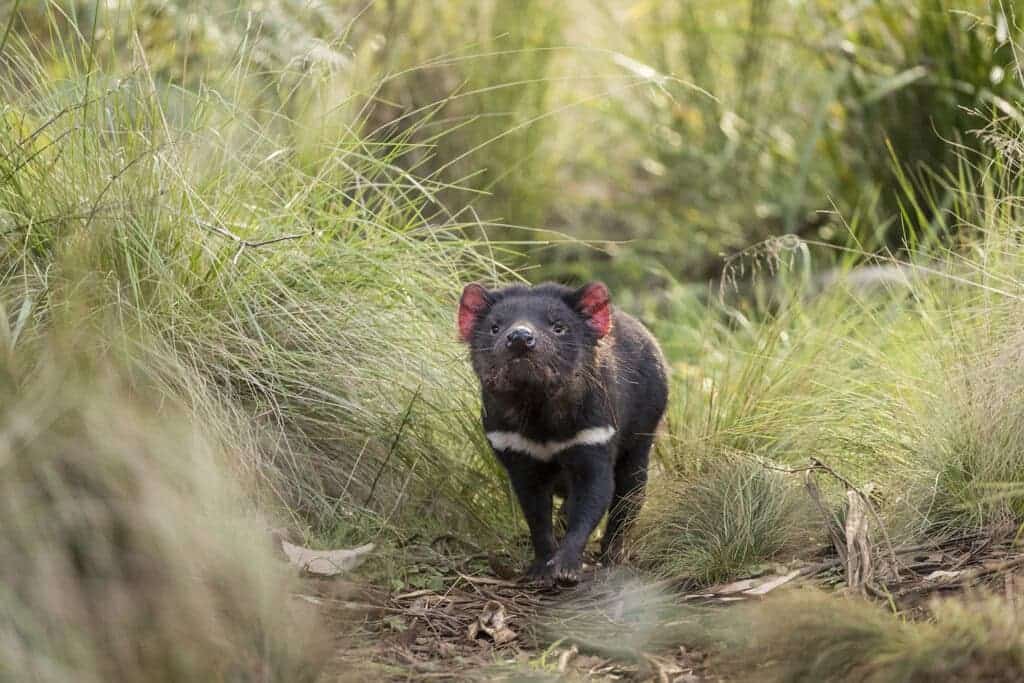
Around 3,000 years ago, Tasmanian devils were driven out from mainland Australia by dingoes introduced by Sulawesi hunter-gatherers. Fortunately, dingoes never made it to the island of Tasmania, the namesake of the devils, which helped the aggressive scavengers avoid extinction. But recent challenges such as habitat loss and the spread of one of the only known contagious cancers in the world are casting doubt on the fate of the iconic mammal.
With just 25,000 devils left in the wild in Tasmania, today’s announcement of their reintroduction to the Australian mainland marks a historic moment.
“In 100 years, we are going to be looking back at this day as the day that set in motion the ecological restoration of an entire country,” said Tim Faulkner, president of Aussie Ark. “Not only is this the reintroduction of one of Australia’s beloved animals, but of an animal that will engineer the entire environment around it, restoring and rebalancing our forest ecology after centuries of devastation from introduced foxes and cats and other invasive predators. Because of this reintroduction and all of the hard work leading up to it, someday we will see Tasmanian devils living throughout the great eastern forests as they did 3,000 years ago.”
Back home
Aussie Ark, an Australian non-profit that aims to protect the country’s endangered species, has been breeding Tasmanian devils (Sarcophilus harrisii) in captivity since 2011. The organization has so far been responsible for raising nearly 400 devils in a habitat that fosters their sense of independence and all the necessary skills they require to survive in the wild.
In partnership with Global Wildlife Conservation and WildArk, Aussie Ark released 11 devils into a 400-hectare wildlife sanctuary on Barrington Tops. The individuals were selected so that they can mate with one another without any inbreeding, and biologists at the wildlife sanctuary hope that this initial small population will soon grow in numbers.
As apex predators and the world’s largest carnivorous marsupials, the devils will help balance the ecosystem by controlling invasive species such as feral cats and foxes that threaten endemic species.
“The re-introduction of devils to mainland Australia is a game-changer for conservation in this country, not only building a robust, genetically healthy population outside of Tasmania, but also paving the way for future introductions that the Aussie Ark team are already mapping out,” said Mark Hutchinson, co-founder of WildArk. “Having partnered with Aussie Ark and GWC on the Koala Comeback Campaign after the bushfires this year, we’ve witnessed first-hand their commitment to ecological restoration in Eastern Australia and we couldn’t be prouder to now support the Devil Comeback. The groundwork is being laid for a broad, nationwide effort to rewild Australia and help our little critters find their niche again.”
In recent years, life hasn’t been easy for the Tasmanian devils. In 1996, the first case of devil facial tumor disease (DFTD) was reported by scientists. It’s only one of three transmissible cancers known to man (the other being in dogs and shellfish), but also one of the most unforgiving, having an almost 100% kill rate. Today, wild populations of the iconic Australian marsupial are down 90% and many researchers fear the devil may be doomed unless something is done about it — and fast.
To make matters worse, devastating fires across the continent earlier this year destroyed 72,000 square miles of forest and claimed the lives of nearly 3 billion wildlife.
“The fires earlier this year were absolutely devastating and threatened to rob us of our hope,” Faulkner said. “This is our response to that threat of despair: come what may, ultimately we will not be deterred in our efforts to put an end to extinction and to rewild Australia.”
Their introduction to mainland Australia might help swell their numbers, as well as bring them into new habitats away from the dreaded DFTD’s reach.
Aussie Ark plans on introducing 40 devils to the wild over the next two years. Each animal is fitted with radio collars that monitor their location and movements. Additionally, camera traps in key locations will help conservation scientists keep a close eye on the devils.






